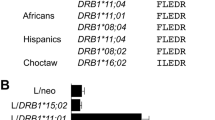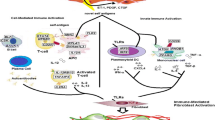Abstract
Purpose of the Review
Nowadays, important advances have occurred in our understanding of the pathogenesis of systemic sclerosis (SSc), which is a rare immune-mediated inflammatory disease (IMID) characterized by vascular damage, immune imbalance, and fibrosis. Its etiology remains unknown; nevertheless, both environmental and genetic factors play a major role in the disease. This review will focus on the main advances made in the field of genetics of SSc.
Recent Findings
The assessment of how interindividual genetic variability affects disease onset and progression has enhanced our knowledge of disease biology, and this will eventually translate in the development of new diagnostic and therapeutic tools, which is the final goal of personalized medicine.
Summary
We will provide an overview of the most relevant achievements in the genetics of SSc, its shared genetics among IMIDs with special attention on drug repurposing, current challenges for the functional characterization of risk variants, and future directions.


Similar content being viewed by others
Change history
14 August 2019
The original version of this article unfortunately contained a mistake. The legend of Fig. 1 was incorrect.
References
Papers of particular interest, published recently, have been highlighted as: • Of importance •• Of major importance
Gabrielli A, Avvedimento EV, Krieg T. Scleroderma. N Engl J Med. 2009;360(19):1989–2003.
Katsumoto TR, Whitfield ML, Connolly MK. The pathogenesis of systemic sclerosis. Annu Rev Pathol. 2011;6:509–37.
Denton CP, Khanna D. Systemic sclerosis. Lancet. 2017;390(10103):1685–99.
Arnett FC, Cho M, Chatterjee S, Aguilar MB, Reveille JD, Mayes MD. Familial occurrence frequencies and relative risks for systemic sclerosis (scleroderma) in three United States cohorts. Arthritis Rheum. 2001;44(6):1359–62.
Feghali-Bostwick C, Medsger TA Jr, Wright TM. Analysis of systemic sclerosis in twins reveals low concordance for disease and high concordance for the presence of antinuclear antibodies. Arthritis Rheum. 2003;48(7):1956–63.
Assassi S, Arnett FC, Reveille JD, Gourh P, Mayes MD. Clinical, immunologic, and genetic features of familial systemic sclerosis. Arthritis Rheum. 2007;56(6):2031–7.
Gorlova OY, Li Y, Gorlov I, Ying J, Chen WV, Assassi S, et al. Gene-level association analysis of systemic sclerosis: a comparison of African-Americans and White populations. PLoS One. 2018;13(1):e0189498.
Bossini-Castillo L, Lopez-Isac E, Martin J. Immunogenetics of systemic sclerosis: defining heritability, functional variants and shared-autoimmunity pathways. J Autoimmun. 2015;64:53–65.
Eyre S, Orozco G, Worthington J. The genetics revolution in rheumatology: large scale genomic arrays and genetic mapping. Nat Rev Rheumatol. 2017;13(7):421–32.
Cortes A, Brown MA. Promise and pitfalls of the Immunochip. Arthritis Res Ther. 2011;13(1):101.
Nelson MR, Tipney H, Painter JL, Shen J, Nicoletti P, Shen Y, et al. The support of human genetic evidence for approved drug indications. Nat Genet. 2015;47(8):856–60.
Radstake TR, et al. Genome-wide association study of systemic sclerosis identifies CD247 as a new susceptibility locus. Nat Genet. 2010;42(5):426–9.
Dieude P, Boileau C, Guedj M, Avouac J, Ruiz B, Hachulla E, et al. Independent replication establishes the CD247 gene as a genetic systemic sclerosis susceptibility factor. Ann Rheum Dis. 2011;70(9):1695–6.
Allanore Y, Saad M, Dieudé P, Avouac J, Distler JHW, Amouyel P, et al. Genome-wide scan identifies TNIP1, PSORS1C1, and RHOB as novel risk loci for systemic sclerosis. PLoS Genet. 2011;7(7):e1002091.
Bossini-Castillo L, Martin JE, Broen J, Simeon CP, Beretta L, Gorlova OY, et al. Confirmation of TNIP1 but not RHOB and PSORS1C1 as systemic sclerosis risk factors in a large independent replication study. Ann Rheum Dis. 2013;72(4):602–7.
Zhou X, Lee JE, Arnett FC, Xiong M, Park MY, Yoo YK, et al. HLA-DPB1 and DPB2 are genetic loci for systemic sclerosis: a genome-wide association study in Koreans with replication in North Americans. Arthritis Rheum. 2009;60(12):3807–14.
Bossini-Castillo L, Martin JE, Broen J, Gorlova O, Simeón CP, Beretta L, et al. A GWAS follow-up study reveals the association of the IL1e2RB2 gene with systemic sclerosis in Caucasian populations. Hum Mol Genet. 2012;21(4):926–33.
Martin JE, Broen JC, Carmona FD, Teruel M, Simeon CP, Vonk MC, et al. Identification of CSK as a systemic sclerosis genetic risk factor through genome wide association study follow-up. Hum Mol Genet. 2012;21(12):2825–35.
Lopez-Isac E, et al. A genome-wide association study follow-up suggests a possible role for PPARG in systemic sclerosis susceptibility. Arthritis Res Ther. 2014;16(1):R6.
Mayes MD, Bossini-Castillo L, Gorlova O, Martin JE, Zhou X, Chen WV, et al. Immunochip analysis identifies multiple susceptibility loci for systemic sclerosis. Am J Hum Genet. 2014;94(1):47–61.
Zochling J, Newell F, Charlesworth JC, Leo P, Stankovich J, Cortes A, et al. An Immunochip-based interrogation of scleroderma susceptibility variants identifies a novel association at DNASE1L3. Arthritis Res Ther. 2014;16(5):438.
Cheung MW, Vijayakumar R. A guide to conducting a meta-analysis. Neuropsychol Rev. 2016;26(2):121–8.
•• Genetics for all. Nat Genet, 2019. 51(4): p. 579. This editorial shows how most of the genetic studies haven been carried out in European populations and how this will bias their impact on health in genetically diverse populations.
• Terao C, Kawaguchi T, Dieude P, Varga J, Kuwana M, Hudson M, et al. Transethnic meta-analysis identifies GSDMA and PRDM1 as susceptibility genes to systemic sclerosis. Ann Rheum Dis. 2017;76(6):1150–8 This study represents the first transethinic meta-analysis in SSc among European and Asian population, highlighting the potential of studying other populations to find new genetic risk factors in complex diseases.
• Gonzalez-Serna D, et al. Analysis of the genetic component of systemic sclerosis in Iranian and Turkish populations through a genome-wide association study. Rheumatology (Oxford). 2019;58(2):289–98 This paper confirms the association of the classical allele HLA-DRB1*11:04 with SSc in several populations.
Gorlova O, Martin JE, Rueda B, Koeleman BPC, Ying J, Teruel M, et al. Identification of novel genetic markers associated with clinical phenotypes of systemic sclerosis through a genome-wide association strategy. PLoS Genet. 2011;7(7):e1002178.
Simeon CP, et al. Association of HLA class II genes with systemic sclerosis in Spanish patients. J Rheumatol. 2009;36(12):2733–6.
Arnett FC, Gourh P, Shete S, Ahn CW, Honey RE, Agarwal SK, et al. Major histocompatibility complex (MHC) class II alleles, haplotypes and epitopes which confer susceptibility or protection in systemic sclerosis: analyses in 1300 Caucasian, African-American and Hispanic cases and 1000 controls. Ann Rheum Dis. 2010;69(5):822–7.
Beretta L, Rueda B, Marchini M, Santaniello A, Simeon CP, Fonollosa V, et al. Analysis of class II human leucocyte antigens in Italian and Spanish systemic sclerosis. Rheumatology (Oxford). 2012;51(1):52–9.
Rodriguez-Reyna TS, Mercado-Velázquez P, Yu N, Alosco S, Ohashi M, Lebedeva T, et al. HLA class I and II blocks are associated to susceptibility, clinical subtypes and autoantibodies in Mexican systemic sclerosis (SSc) patients. PLoS One. 2015;10(5):e0126727.
Parkes M, Cortes A, van Heel DA, Brown MA. Genetic insights into common pathways and complex relationships among immune-mediated diseases. Nat Rev Genet. 2013;14(9):661–73.
Zhernakova A, Withoff S, Wijmenga C. Clinical implications of shared genetics and pathogenesis in autoimmune diseases. Nat Rev Endocrinol. 2013;9(11):646–59.
Martin JE, Assassi S, Diaz-Gallo LM, Broen JC, Simeon CP, Castellvi I, et al. A systemic sclerosis and systemic lupus erythematosus pan-meta-GWAS reveals new shared susceptibility loci. Hum Mol Genet. 2013;22(19):4021–9.
Lopez-Isac E, et al. Brief report: IRF4 newly identified as a common susceptibility locus for systemic sclerosis and rheumatoid arthritis in a cross-disease meta-analysis of genome-wide association studies. Arthritis Rheumatol. 2016;68(9):2338–44.
Li YR, Li J, Zhao SD, Bradfield JP, Mentch FD, Maggadottir SM, et al. Meta-analysis of shared genetic architecture across ten pediatric autoimmune diseases. Nat Med. 2015;21(9):1018–27.
Ellinghaus D, et al. Analysis of five chronic inflammatory diseases identifies 27 new associations and highlights disease-specific patterns at shared loci. Nat Genet. 2016;48(5):510–8.
•• Marquez A, et al. Meta-analysis of Immunochip data of four autoimmune diseases reveals novel single-disease and cross-phenotype associations. Genome Med. 2018;10(1):97 This study shows the common genetic architecture of SSc with other autoimmune diseases and its potential on drug repositioning.
•• Acosta-Herrera M, et al. Genome-wide meta-analysis reveals shared new loci in systemic seropositive rheumatic diseases. Ann Rheum Dis. 2019;78(3):311–9 This paper identifies shared genetics across systemic seropositive rheumatic diseases with functional value and significantly enriched in drug targets, calling our attention on their potential for drug repurposing.
•• Angiolilli C, et al. New insights into the genetics and epigenetics of systemic sclerosis. Nat Rev Rheumatol. 2018;14(11):657–73 This review shows how different epigenetic studies in SSc might impact on the treatment of the disease.
• van der Kroef M, et al. Histone modifications underlie monocyte dysregulation in patients with systemic sclerosis, underlining the treatment potential of epigenetic targeting. Ann Rheum Dis. 2019;78(4):529–38 This study is an example of how epigenetic modifications can be targeted for the development of new therapies in SSc.
Roadmap Epigenomics C, et al. Integrative analysis of 111 reference human epigenomes. Nature. 2015;518(7539):317–30.
Schoenfelder S, Clay I, Fraser P. The transcriptional interactome: gene expression in 3D. Curr Opin Genet Dev. 2010;20(2):127–33.
Martin P, McGovern A, Orozco G, Duffus K, Yarwood A, Schoenfelder S, et al. Capture Hi-C reveals novel candidate genes and complex long-range interactions with related autoimmune risk loci. Nat Commun. 2015;6(6):10069.
•• Schoenfelder, S., et al., Long-range enhancer-promoter contacts in gene expression control. Nat Rev Genet, 2019. In press. This review goes over the enhancer-promoter interactions in the genome and their impact on development and disease.
• Martin, P., et al., Chromatin interactions reveal novel gene targets for drug repositioning in rheumatic diseases. Ann Rheum Dis, 2019. In press. This paper is an example of how functional genomics is an effective tool to identify new treatments and drug repurposing in related diseases.
McGovern A, et al. Capture Hi-C identifies a novel causal gene, IL20RA, in the pan-autoimmune genetic susceptibility region 6q23. Genome Biol. 2016;17(1):212.
•• Torkamani A, et al. The personal and clinical utility of polygenic risk scores. Nat Rev Genet. 2018;19(9):581–90 This study reviews the clinical utility of polygenic risk scores.
GWAS to the people. Nat Med. 2018;24(10):1483.
Schork AJ, Schork MA, Schork NJ. Genetic risks and clinical rewards. Nat Genet. 2018;50(9):1210–1.
Hunter DJ, Drazen JM. Has the genome granted our wish yet? N Engl J Med. 2019;380(25):2391–3.
• Khera AV, et al. Genome-wide polygenic scores for common diseases identify individuals with risk equivalent to monogenic mutations. Nat Genet. 2018;50(9):1219–24 This paper highlights the impact of stratifying patients at risk based on polygenic risk scores to enable early disease detection and intervention. The authors discuss how genetic prediction should be included into medical care.
Funding
This work was supported by the Cooperative Research Thematic Network (RETICS) program (RD16/0012/0013) (RIER) from the Health Institute Carlos III (ISCIII) and (SAF2015–66761-P) Spanish Ministry of Economy, Industry and Competitiveness.
Author information
Authors and Affiliations
Corresponding authors
Ethics declarations
Conflict of Interest
The authors declare that they have no conflict of interest.
Human and Animal Rights and Informed Consent
This article does not contain any studies with human or animal subjects performed by any of the authors.
Additional information
Publisher’s Note
Springer Nature remains neutral with regard to jurisdictional claims in published maps and institutional affiliations.
The original version of this article was revised: The legend of Fig. 1 was corrected. Full information regarding the correction made can be found in the erratum/correction for this article.
This article is part of the Topical Collection on Scleroderma
Rights and permissions
About this article
Cite this article
Acosta-Herrera, M., López-Isac, E. & Martín, J. Towards a Better Classification and Novel Therapies Based on the Genetics of Systemic Sclerosis. Curr Rheumatol Rep 21, 44 (2019). https://doi.org/10.1007/s11926-019-0845-6
Published:
DOI: https://doi.org/10.1007/s11926-019-0845-6




